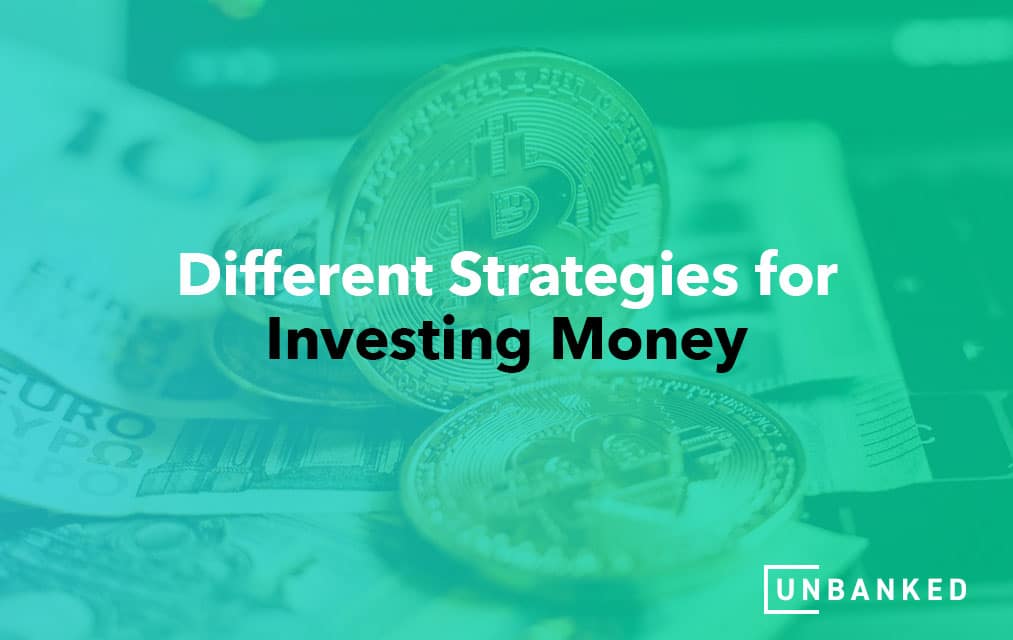There are various strategies that investors use to invest their money, and the best part is that they are quite flexible. You can change or alter your strategy based on your risk tolerance and how much capital you have to invest, but it’s possible to see significant losses if you change strategies constantly—each stock purchase comes with fees. Also, selling assets creates capital gains, which are taxable and can be expensive.
We’ll look at the top five strategies for investing money that suit most investors. After learning about the different strategies of investing money, you can choose which ones suit your needs the best. But first, let’s see what you need before you get started.
Related: 10 Reasons to Go unBanked
Before You Begin
Before choosing an investment strategy, it’s crucial to have a clear picture of your financial situation. Consider your cost of living, expenses, and debts, and the capital that you can afford to invest initially and later on down the road. Even though you can start investing without a large amount of money, it’s important that you only invest the amount you can afford. If you have lots of debt, it’s essential to understand how investing money will impact your ability to pay your monthly obligations.
You’ll also want to set clear goals for yourself—why do you want to invest? Some common investing goals are saving for retirement, a down payment, or a college education (either for yourself or a family member). Generally, the younger the investor, the more risk they can afford to take on their investments. Higher risk means the potential for higher returns, but it also means there’s a more significant potential for losses.
Now, let’s look at some of the basic investing strategies:
- Buy and hold strategies.
- Value investing.
- Growth investing.
- Momentum investing.
- Dollar-cost averaging.
Buy and Hold Strategies
Buy and hold investing strategies are more about time spent in the market than timing the market itself. It works by holding investments over long periods—buy and hold investors believe that long-term returns from this strategy outperform typical market volatility. Investment portfolios of buy and hold investors are known as “lazy portfolios” because they are low-maintenance investments. There are five popular methods for buy and hold investors:
- Modern portfolios: The modern portfolio theory is a strategy that investors use in an attempt to get the most returns with minimal risks. The entire basis of this theory is that diversification is critical to minimize risks—investors hold high-risk investments in combination with various other types of assets to balance out the overall risk of their portfolio.
- Post-Modern portfolios: The most significant difference between a modern and post-modern portfolio is how they define risks when putting together investment assets. The post-modern portfolio theory takes an asymmetrical approach on investor’s behavioral aspects—losses don’t have an equal behavioral impact as gains do. This strategy takes into account investor mindsets rather than entirely relying on mathematical models like modern portfolios.
- Core and Satellite: Core and Satellite portfolios are a time-tested design that investors have been using for ages. It consists of “Core” funds like large-cap mutual funds that represent most of the portfolio and “Satellite” funds that consist of much smaller investments to round out the portfolio. Its objective is to offer diversification while outperforming standard benchmarks, like the S&P 500 index.
- Dave Ramsey-style: Dave Ramsey, the popular finance “guru,” offers his own buy and hold strategy for investors. This portfolio consists of four mutual funds—it’s easy to build and follow but comes with a major disadvantage: the funds often overlap, meaning there is little diversity. It also doesn’t utilize lower-risk assets like bonds, which means investors could take bigger hits than with other buy and hold strategies.
- Tactical asset allocation: The fifth buy and hold portfolio strategy is a combination of the above. It has three asset classes: bonds, stocks, and cash. These assets get actively balanced by the investor in hopes of maximizing returns while minimizing risks compared to a benchmark. It focuses mainly on asset allocation, with investment selection being less important—this is a big-picture view that investors can take to minimize their risks more than with other strategies.
Value Investing
Value investing is similar to shopping for bargains—investors look to purchase stocks that they think are worth more than the selling price. Value investors watch out for stocks that have prices that don’t entirely reflect their value. The art of value investing relies on the idea that irrationality exists in the stock market. In theory, that irrationality gives investors an opportunity to buy stocks at lower prices than they are worth.
For beginner value investors, researching high volumes of financial data isn’t really necessary—there are many mutual funds available that consist of baskets of stocks that are believed to be undervalued.
One downside to value investing is that it can be quite costly to change strategies on the fly since profiting from value investing relies on the stocks you purchased going up in the future. Even though many investors will pull out on the strategy if their stocks underperform, leading to losses for them and smaller gains for investors who are stuck with their picks.
Value investing is more about investing in the business itself rather than its stocks. It’s a long-term strategy where investors look at the big picture rather than hope for quick returns.
Tools for Value Investing
Investors who don’t want to worry about performing extensive research on businesses to invest in can use the price-earning ratio as an effective tool to identify undervalued stocks. This ratio is a number that comes from taking a stock’s share price and dividing that by its earnings per share. The lower the ratio, the better for value investing.
The price-earning ratio is a good place to start, but you shouldn’t choose investments based on that number alone. Sometimes, the ratio can look higher than it truly is based on inflated accounting numbers. Since you can’t rely solely on the price-earning ratio, how can investors find the stock’s true value? By also looking at its quality, momentum, and profitability measures, investors can avoid purchasing shares that have artificially low price-earnings ratios.

Growth Investing
Unlike value investing, growth investors look for stocks that have a strong potential to rise in price in the future. Growth investing relies on investors to pick up-and-coming stocks of companies that they believe will be the next big thing in their industry. Even though growth investing might sound like it involves mostly speculation, it requires research of various companies to determine the health and growth potential of different stocks.
Growth investors look at industry leaders in certain sectors and choose which ones they believe will have the means to outperform their competitors. Usually, that means investors will look for evidence of growth and a widespread need for the company’s products or services. Growth investors also look for companies that deliver consistent trends of high revenue and earnings.
A downside of growth investing is that it doesn’t pay very much in dividends. When companies focus on growth, most of their capital gets used for expanding, which doesn’t leave much left for dividend payments. Faster growth also means higher valuations, which comes with more risk for investors.
Does it Work?
Over the long term, value investing usually outperforms growth investing, but that doesn’t mean growth investing isn’t a good strategy for some investors. While growth investing may not typically generate the long-term returns that value investing does, growth strategies work very well during times when the gross domestic product (GDP) trends downward.
Variables of Growth Investing
When it comes to the metrics of a growth investing strategy, here’s not a definitive list, but there are some things that investors should keep in mind. For example, growth stocks perform the best when interest rates are falling, so it’s important for investors to watch the economy closely—the beginning of a downward trend is when growth stocks get hit the hardest.
Investors employing a growth investing strategy should also consider how the management of the company they invest in works. Growing a company is one of the biggest challenges for businesses, and for growth investing to work, the management must be exceptional—growth isn’t of much value if it comes from heavy borrowing. Investors should also check out the competition—if another company can easily replicate their products or services, the long-term prospects of growth are relatively low.
Momentum Investing
Momentum investing is based on the thought that rising stocks will continue to rise and falling stocks will continue to fall. Momentum investors purchase stocks that trend upwards, and they typically short-sell stocks that experience downward trends. Note: short-selling is a risky strategy—we’ll go over why that is further in the article.
Momentum investors make their buying decisions based on data, and they look for stock price patterns to determine how they make purchasing decisions. There’s a practice in investing called the efficient-market hypothesis that states asset prices are based on publicly available information—momentum investors defy that “rule” by seeking to capitalize on over and undervalued stocks.
Does Momentum Investing Work?
It depends. Investors using a momentum strategy need to be ready to buy and sell at any time—the profit comes in at a much shorter term than the previously mentioned strategies (think months, not years). For investors interested in the momentum strategy but don’t want to watch the market constantly, momentum-style exchange-traded funds (ETFs) can give them exposure to this strategy with slightly fewer risks.
Momentum Investing & Shorting
We mentioned that short-selling is a risky maneuver—it’s a way for more aggressive investors to try and maximize their returns. Shorting a momentum investment lets investors profit when a share drops in price, but the potential for profit comes with an extremely high risk of losses. With most investments, you can only lose what you put in initially, but with short-selling, you can lose even more than your initial investment. We only advise this investing for advanced and experienced investors.
Dollar-Cost Averaging
Dollar-cost averaging is an investing strategy where the investor purchases regular investments over time—it’s not mutually exclusive to any methods; it’s a way of executing your chosen strategy. Dollar-cost averaging is an approach that becomes particularly effective when investors use automated tools for investing.
The benefit of dollar-cost averaging is that it helps investors avoid losses from bad market timing. Even the most experienced investors purchase stocks at low prices only for them to continue falling—investing in regular increments with dollar-cost averaging lets investors obtain stocks at various levels of prices from high to low. Periodically investing like this lowers the average cost per share of each purchase.
Who Should Choose Dollar-Cost Averaging Investing?
Most investors can get a good experience from dollar-cost averaging. It can help reduce risks and the effects caused by market volatility but isn’t the best strategy for investors who want to invest a lump sum. But, because most investors aren’t in the position to make a lump sum investment, the dollar-cost averaging strategy gets used by many. Dollar-cost averaging removes the human bias from investing, which can cause problems for experienced and beginner investors alike. For investors who want to minimize downside risk, this is a great strategy to look into further.
What to Do After Choosing an Investment Strategy

After deciding on an investment strategy that suits your needs, there are a few things to take care of before you begin making purchases. The first thing to do is decide how much money you want to invest initially and moving forward. Then, you’ll need to choose a broker or financial advisor to start your investment account with and figure out what fees you’ll have to pay.
Note: don’t forget about employer-sponsored 401ks if you have the option!
Next, you’ll want to decide on the type of investments you want to make, e.g., stocks, bonds, ETFs, or mutual funds. It’s a good idea to diversify your investments across different investment vehicles—it’s not recommended to put all of your money into a single one.
What’s the next step of your investing journey? Browse through our free investing resources at unBanked!
Related: What Is unBanked?





